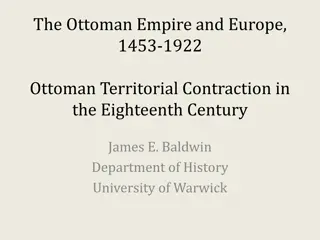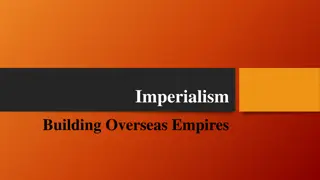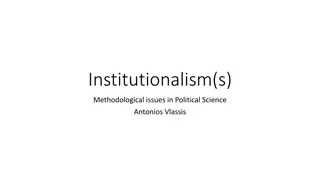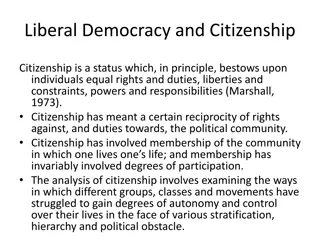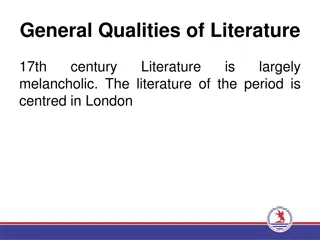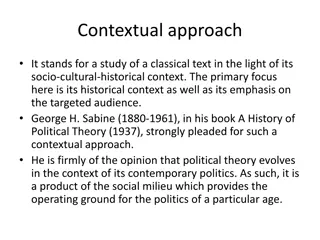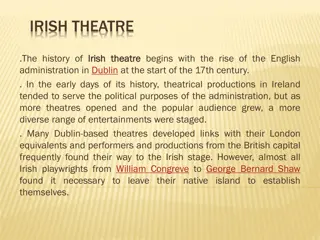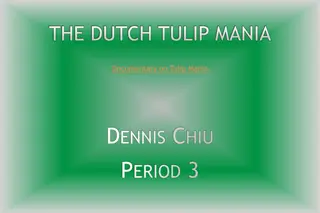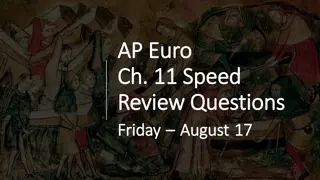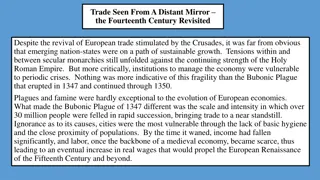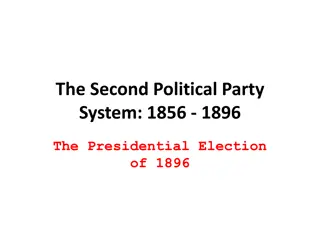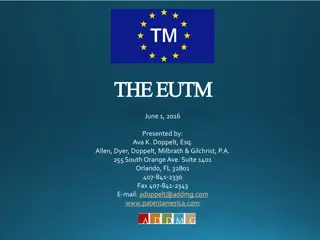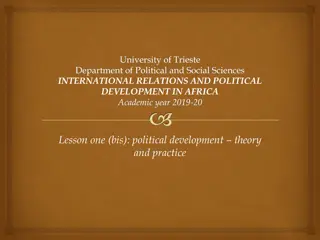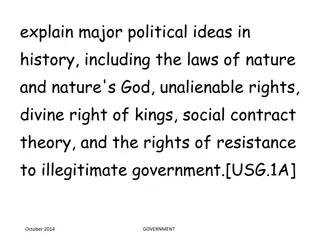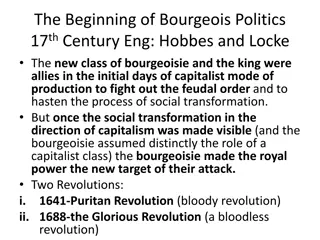European Political Landscape in the Early 17th Century
Central Europe in 1618 was marked by conflicts and power struggles among various entities such as the Bishopric of Hildesheim and the Duchy of Brunswick-Wolfenbüttel. The inability to achieve peace in 1635 and beyond was fueled by factors such as France's increasing revenue and military spending, financial challenges in Saxony and the Empire, wars with the Dutch, objectives set by Olivares, conflicts with France, and shifting alliances in the region. The attitudes toward conflicts between Spain, the Dutch Republic, and the Holy Roman Empire remained complex due to ongoing power dynamics.
Download Presentation

Please find below an Image/Link to download the presentation.
The content on the website is provided AS IS for your information and personal use only. It may not be sold, licensed, or shared on other websites without obtaining consent from the author.If you encounter any issues during the download, it is possible that the publisher has removed the file from their server.
You are allowed to download the files provided on this website for personal or commercial use, subject to the condition that they are used lawfully. All files are the property of their respective owners.
The content on the website is provided AS IS for your information and personal use only. It may not be sold, licensed, or shared on other websites without obtaining consent from the author.
E N D
Presentation Transcript
Central Europe, 1618 Bishopric of Hildesheim, Duchy of Brunswick- Wolfenb ttel
Why did peace remain elusvie in 1635 and afterwards?
France increase in revenue: 32.5 M livres (1610) 57.5 M livres (1635) 79 m livres (1643) increases in military spending: 16 M livres (1620s) 33 M livres (1635) 38 M livres (after 1640) overspending, borrowing Revenue was not only spent before it was collected, but large parts of the fiscal system were transferred into private hands, largely beyond government control (p. 558)
Saxony debt 7 M fl. (1628) 25.2 M fl. (1657) Empire 1635: at most 8 M fl. to fund Imperial army problems no funds from northern territories held by Sweden competition between taxes for Imperial army and money raised to fund regional armies (Bavaria, Saxony) decline in size of armies it was now difficult to launch major operations in more than one region at a time (p. 619)
war with the Dutch Olivares objectives: achieve military superiority in Flanders force Dutch to accept an honourable peace (p. 555) 2 February 1635: Spanish Council of State made the war with the Dutch a priority 31 October 1634: Treaty of Ebersdorf: Imperial assistance for war against the Dutch
conflict with France? 13 April 1634: Spanish Council of State against war 12 May 1634: secret agreement with Gaston d Orl ans: troops and money for an invasion of France 26 March 1635: arrest of Philipp Christoph von S tern, Archbishop Elector or Trier April 1635: capture of Koblenz
attitudes to conflict between Spain-Dutch Republic, HRE-Sweden Both Protestant powers remained counterweights to perceived Spanish dominance (p. 555). 8 February 1635: offensive alliance with the Dutch Republic to invade Spanish Netherlands declaration of war on Spain: 26 May 1635
Franco-Dutch invasion of Spanish Netherlands repulsed France co-opted Bernhard of Weimar southern front: Lorraine, Alsace, Franche-Comt fall of Mainz to Imperial forces: January 1636 Spanish invasion of France Corbie: Spain: 15 August 1636 France: 14 November 1636
Read Sourcebook, document 103. Be prepared to answer the questions below in class. 1. What are the most important articles of the Peace of Prague? Identify them by number. Why do you think they are important? 2. Do the provisions of the Peace of Prague suggest that the conflict it aimed to end was religious? 3. Does it make sense to describe the Peace of Prague as a Peace without peace ? Why or why not?
objectives unity of imperial estates military superiority expulsion of foreigners Peace of Prague (30 May 1635) The Peace did not make Ferdinand an absolute monarch, and his intention was to restore what he regarded as the proper constitutional order (p. 566). a monarchical solution (p. 566) a degree of imperial authority unacceptable to Sweden and France (p. 566) defeat of militant Catholics 1. 2. 3.
dissolution of all alliances, including Catholic League a new Imperial army separate corps for Bavaria, Saxony transfer of Lusatia to Saxony no recognition of Calvinism 1627: a new normative year after which Protestant control of Catholic church property was invalid details left to biconfessional committee agreement between Emperor and Saxony invitation of other states
exclusion of many members of the Heilbronn League Palatine, Hessen-Kassel, W rttemberg, Hohenlohe counts amnesty question ultimately wrecked the Peace (p. 571) Ferdinand made it much harder to resolve the amnesty question by enlarging the numbers of those with a vested interest in opposing a pardon. Yet, by excluding so many, he undermined the desired character of Prague as a general peace (p. 572) Imperial ban for Landgrave Wilhelm V of Hessen- Kassel (October 1635)
Read Sourcebook, documents 104, 106, 107, 108. Be prepared to answer the questions below in class. 1. What were Sweden s objectives in 1635? 2. Why did it pursue these objectives? 3. How would you characterize the outlook of Sweden s decision makers?
Powder Barrel Convention, 21 August 1635 disgruntled German officers and Oxenstierna Stuhmsdorf Truce, 12 September 1635 extension of Truce of Altmark (Poland and Sweden) Saxony s relative failure to appeal to German patriotism Treaty of Wismar, 1636 French subsidies used for raising fresh troops Sweden obliged not to make peace without France unratified
Sweden: Johan Banr Imperial Army: Melchior Hatzfeldt one of the most important battles of the war (p. 583)
Ferdinand III (1637-1657) electoral congress in Regensburg, 1636-1637 money from Spain election of Ferdinand co-operation from Brandenburg inadequate confessional co- operation to deal with Sweden continued reluctance to support Spain against the Dutch desire to solve amnesty question thwarted (p. 612)
Wilhelm V of Hessen- Kassel (d. 1 October 1637) alliance with France (1636) Imperial invasion (April 1637) truce with Emperor under Amalie Elizabeth (1638)
Treaty of Hamburg (15 March 1638) renewal of Franco-Swedish alliance extension of French subsidies Sweden remained outside of war between France and Spain. Karl Ludwig of the Palatinate failed attempt to take the Rhenish Palatinate (1638) defeated by Imperial army (p. 594)
Partisans (p. 601) Konrad Widerhold (1598?- 1667) humble origins significance
Rhineland French surrender of Ehrenbreitstein (June 1637)
Rhineland Battles of Rheinfelden 28 February 1638: Imperialist victory 3 March 1638: French victory under Bernhard von Weimar Battle of Wittenweier (8 August 1638) French victory under Bernhard von Weimar Fall of Breisach (19 December 1638) French victory under Bernhard von Weimar control of Alsace The war had shifted deeper into the Empire (p. 611)
The North Swedish retreat, summer 1637 under Johan Ban r loss of poorly defended fortresses secure in Baltic bridgehead: Stettin, 1638 Treaty of Hamburg, 15 March 1638 Mecklenburg recaptured
The North Ban r s foray into Saxony, Bohemia (1639) Guelphs, Hessen- Kassel send troops to Ban r Ban r blockaded Wolfenb ttel (1639) imperial garrison here as leverage for bishopric of Hildesheim
Year 1620 1631 1631 1632 1634 1636 Battle White Mountain Magdeburg Breitenfeld L tzen N rdlingen Wittstock
Read Sourcebook, documents 109, 112. Be prepared to answer the questions below in class. 1. What do the retrospectives of Cardinal Richelieu and Maximilian of Bavaria tell us of their interpretations of the Thirty Years War? Pay attention to what they say, how they say it, and what they do not say.






